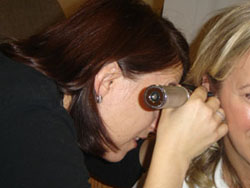toh
Services
Referrals from a physician are required. Services of an interpreter are available on request.
Cost of services
Ontario residents must have a valid provincial health card in order for the provincial health insurance to cover the cost of services that we provide.
Note: Not all audiological services are covered by OHIP. For example, there is a fee for services related to hearing aids.
Costs are covered for residents of other Canadian provinces who present a valid provincial health card when they come for their appointment.

Description of Services
Auditory Brainstem testing (ABR)
ABR is a useful diagnostic tool that measures brain wave activity from the hearing centres in the brain in response to clicking sounds. It can be used to determine if there are any problems with the hearing nerve, or for measuring hearing when more conventional hearing tests cannot be used. The test takes up to an hour, and is painless. Electrodes are attached to the patient’s head, and then the patient listens to clicking sounds. The patient can even sleep during the test.
Hearing aid verification
Hearing aids are tested to make sure that they are working the best they can to assist the hearing problem.
Hearing test
This involves measuring the smallest sound a person hears (threshold) at a variety of frequencies. Results are shown on a graph called an audiogram, which shows the type, degree and configuration of hearing loss.
Impedance testing/tympanometry
This test helps to identify and diagnose middle ear problems. A soft plug is placed in the ear canal, and while listening to a sound, the air pressure in the ear canal is increased or decreased. Results may show abnormalities in the movement of the ear drum or the bones in the middle ear, the presence of fluid in the middle ear space, or holes in the ear drum and how well the middle ear tubes are working.
In addition, an acoustic reflex test may be performed. A soft probe is placed in the ear, and loud tones are produced. This test measures the contraction of a muscle in the middle ear. It can give information about middle ear function, as well as the functioning of the hearing and balance nerves.
Otoacoustic emissions testing (OAE’s)
OAE’s are sounds that are produced by healthy ears in response to other sounds. This test is used to determine the status of the inner ear (cochlea), specifically outer hair cell function. This test may be used to screen hearing, estimate hearing sensitivity within a limited range, or test for functional (faked) hearing loss. A probe is inserted into the ear canal and the client will hear sounds. The client does not need to respond.
Tinnitus Evaluations/Tinnitus Clinic
Testing for Balance and Dizziness Issues
VEMP
VEMP stands for Vestibular Evoked Myogenic Potential and it measures vestibular function. It can be helpful in diagnosing superior semicircular canal dehiscence (SSCD). Electrodes are placed on the forehead and neck, and muscle activity is measured in response to clicking sounds.
VHIT
VHIT stands for Video Head Impulse Testing. It is used to diagnose a reduction in balance function in one ear vs the other ear. The patient wears a set of goggles that records eye movement while the audiologist moves the patient’s head.
VNG/ENG
VNG stands for Videonystagmography. It tests the inner ear, which is a part of the balance system. The patient wears goggles and the test measures eye muscle movements while the patient watches a light move when lying in different positions. Also, the audiologist will direct warm and cool water in the patient’s ears which might cause dizziness for a few minutes.
Last updated on: January 19th, 2022


 To reset, hold the Ctrl key, then press 0.
To reset, hold the Ctrl key, then press 0.